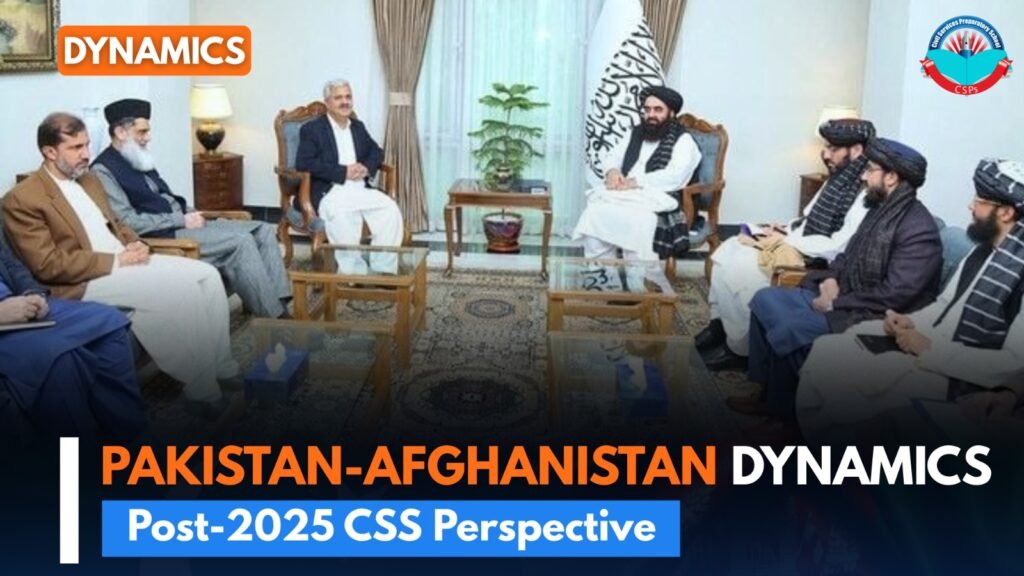1. Introduction: Changing Dynamics After the Taliban Takeover
The fall of Kabul to the Taliban in August 2021 drastically altered the geopolitical landscape of South Asia. Pakistan and Afghanistan — two neighbors bound by geography, culture, and conflict — found themselves navigating a new phase of bilateral relations. As of post-2025, these dynamics remain fluid and complex. Pakistan hoped that a stable Taliban-led government in Kabul would lead to secure borders, reduced terrorism, and better economic engagement. However, the reality has been more complicated.
(For CSS and PMS aspirants, understanding the Pakistan–Afghanistan relationship is crucial, especially given its regular appearance in the Current Affairs, Pakistan Affairs, and International Relations papers.)
2. Border Security, Refugee Influx & Counter-Terrorism Challenges
a) The Durand Line Dilemma
One of the most contentious issues remains the Durand Line, the 2,600 km-long porous border. The Taliban, like previous Afghan governments, have refused to officially recognize it as the international boundary. Border skirmishes — particularly in Chaman and Torkham — have intensified in recent years.
b) TTP Resurgence
Post-2021, Pakistan has witnessed a resurgence of Tehreek-e-Taliban Pakistan (TTP) activities, particularly in Khyber Pakhtunkhwa and Balochistan. Despite the Afghan Taliban’s assurances, TTP militants continue to operate from Afghan soil, straining diplomatic ties.
c) Refugee Pressure
Afghanistan’s internal instability has pushed more refugees toward Pakistan, which already hosts over 1.4 million registered Afghan refugees. The socio-economic and security implications of this influx — especially in light of Pakistan’s fragile economy — are significant.
Key CSS Linkage:
CSS 2022 Current Affairs Paper asked:
“Discuss the strategic and security implications of the Afghan Taliban takeover for Pakistan.”
3. Economic Relations: Trade, Connectivity & Cross-Border Commerce
a) Trade Disruptions
Afghanistan has historically been one of Pakistan’s top export markets. However, trade has declined due to:
Border closures
Taliban-led governance issues
Sanctions and lack of banking access in Afghanistan
As of 2024, bilateral trade stands below $1 billion, down from $2.7 billion in 2011.
b) Pakistan’s Vision: Connectivity through Afghanistan
Pakistan’s long-term economic vision involves using Afghanistan as a transit route to Central Asia, under frameworks like:
China-Pakistan Economic Corridor (CPEC) expansion
CASA-1000 project
Trans-Afghan Railway
However, security concerns and the lack of a recognized Afghan government have hindered progress.
c) Humanitarian Assistance
Pakistan continues to provide food and medical aid to Afghanistan, partly to foster goodwill and partly to prevent further instability that may spill over into its own borders.
4. Regional Stakeholders: The Role of China, the US, and Iran
a) China: Strategic Patience
China’s interests in Afghanistan are shaped by security concerns (especially in Xinjiang) and economic ambitions. It has shown interest in investing in Afghan minerals and possibly extending CPEC. However, like Pakistan, it remains cautious due to Taliban unpredictability.
b) United States: From Withdrawal to Watchfulness
While the US has militarily withdrawn, it retains influence via aid, sanctions, and diplomacy. Pakistan’s perceived support for the Taliban has cooled relations with Washington, but Islamabad still tries to balance diplomacy between Washington and Kabul.
c) Iran: A Rival with Shared Interests
Iran competes with Pakistan for influence in Afghanistan, especially among the Hazara Shia community. However, both nations have common concerns about ISIS-K and narcotics smuggling.
Key CSS Relevance:
Understanding how regional geopolitics affect Pakistan–Afghanistan relations is critical for answering multidimensional CSS essay and current affairs questions.
5. FAQs for CSS Aspirants
Q: Has CSS asked questions about Afghanistan relations in the past?
Yes. Here are some examples:
The 2021 Taliban Takeover of Afghanistan presents regional and global challenges. Elaborate the anticipated policies of the Taliban government and the regional and global response. (CSS 2022)
Some scholars term Afghan Peace Deal as the US Withdrawal Deal. Do you agree? Answer the question while discussing the contours of the Afghan peace process. (CSS 2021)
Q: Which subjects cover this topic?
Pakistan Affairs
Current Affairs
Essay
International Relations (optional)
Q: How can I stay updated on Pakistan–Afghanistan developments?
Follow these platforms:
6. Recommended Books & Reports
a) Books:
Pakistan’s Foreign Policy: A Reappraisal by Shahid M. Amin
The Taliban at War: 2001–2021 by Antonio Giustozzi
No-Win War: The Paradox of US-Pakistan Relations in Afghanistan’s Shadow by Zahid Hussain
Pakistan: Between Mosque and Military by Hussain Haqqani
b) Reports & Resources:
7. Conclusion: Strategic Recommendations for Pakistan
Pakistan must recalibrate its Afghanistan strategy in light of post-2025 realities. Strategic recommendations include:
Border Security: Accelerate fencing and formalize border crossings.
Counter-Terrorism: Demand firm action from the Taliban against TTP sanctuaries.
Refugee Management: Regularize Afghan migration through smart cards and temporary protections.
Economic Engagement: Explore barter trade and banking corridors with Afghanistan under sanctions.
Regional Diplomacy: Rebalance ties with Iran, China, and the US through multilateral engagement.
Final Note for CSS Aspirants
Stay updated, analyze developments critically, and link current events with historical and strategic perspectives. The Pakistan–Afghanistan dynamic is not just a bilateral issue — it is a regional fault line that demands nuanced understanding, especially for competitive exams like CSS and PMS.

